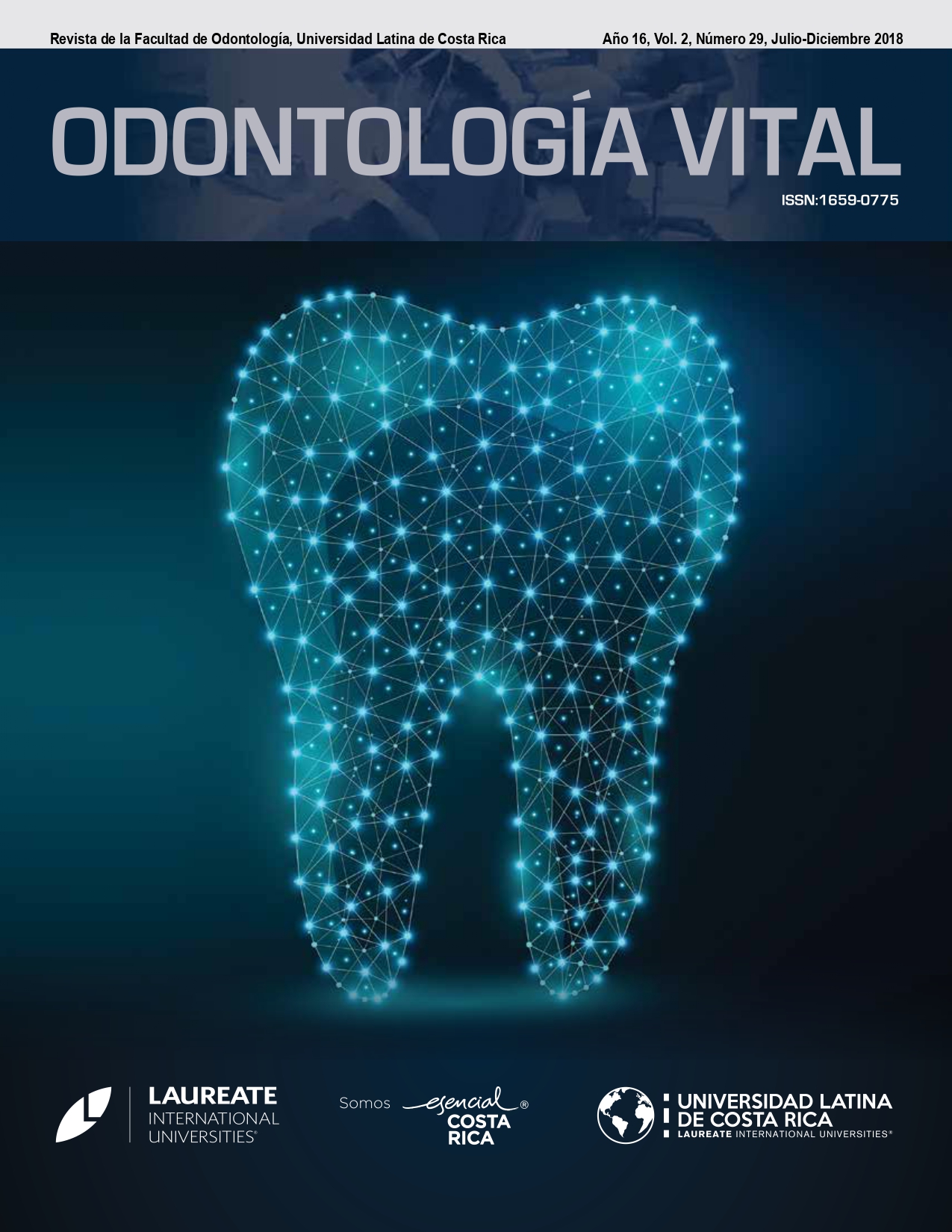Tapón apical con biocerámicos: tratamiento del ápice abierto en una cita
DOI:
https://doi.org/10.59334/ROV.v2i29.146Palabras clave:
Trauma dental, ápice abierto, apexificación en una cita y materiales biocerámicosResumen
El trauma dental es una causa frecuente de necrosis pulpar en piezas anteriores, a edades tempranas, lo que detiene el desarrollo radicular y complica el manejo del caso. La apexificación con hidróxido de calcio ha sido el tratamiento de elección durante muchos años; sin embargo, requiere de muchas citas y se ha informado que su uso a largo plazo puede debilitar las paredes dentinales. Con el surgimiento de los materiales a base de biocerámicos, es posible realizar este tipo de tratamiento en una sola sesión y con resultados más predecibles. Por lo tanto, el objetivo de este artículo es mostrar el manejo de la apexificación en una cita mediante la creación de un tapón apical con MTA y su seguimiento a 4 años.
Descargas
Referencias
Albadri, S., Chau, Y. S., & Jarad, F. (2013). The use of mineral trioxide aggregate to achieve root end closure: three case reports. Dental Traumatology, 29(6), 469-473. https://doi.org/10.1111/j.1600-9657.2012.01128.x
Andersson, L., Andreasen, J. O., & Christensen, K. F. (2011). Writing an original article for publication in Dental Traumatology. Dental Traumatology, 27(5), 328-333. https://doi.org/10.1111/j.1600-9657.2010.00966.x
Bartols, A., Roussa, E., Walther, W., & Dörfer, C. E. (2017). First Evidence for Regeneration of the Periodontium to Mineral Trioxide Aggregate in Human Teeth. Journal of endodontics, 43(5), 715-722. https://doi.org/10.1016/j.joen.2016.12.027
Botero, T. M., Tang, X., Gardner, R., Hu, J. C., Boynton, J. R., & Holland, G. R. (2017). Clinical Evidence for Regenerative Endodontic Procedures: Immediate versus Delayed Induction. Journal of Endodontics, 43(9), S75-S81. https://doi.org/10.1016/j.joen.2017.07.009
Broon, N. J., & Benítez Cabrera, J. G. (2006). Apicogénesis, apicoformación y maturogénesis: conceptos y técnica. Medicina Oral (16656024), 8(3), 129-138.
Bücher, K., Meier, F., Diegritz, C., Kaaden, C., Hickel, R., & Kühnisch, J. (2016). Long-term outcome of MTA apexification in teeth with open apices. Quintessence International, 47(6).
CAMILLERI J., (2016). Is Mineral Trioxide Aggregate a Bioceramic?.-ODOVTOS-Int. J. Dental Sc., 18-1(January-April): 13-17. https://doi.org/10.15517/ijds.v18i1.23482
Çiçek, E., Yılmaz, N., Koçak, M. M., Sağlam, B. C., Koçak, S., & Bilgin, B. (2017). Effect of Mineral Trioxide Aggregate Apical Plug Thickness on Fracture Resistance of Immature Teeth. Journal of Endodontics, 43(10), 1697-170. https://doi.org/10.1016/j.joen.2017.05.007
Flanagan, T. A. (2014). What can cause the pulps of immature, permanent teeth with open apices to become necrotic and what treatment options are available for these teeth. Australian Endodontic Journal, 40(3), 95-100. https://doi.org/10.1111/aej.12087
Fouad, A. F. (2017). Microbial Factors and Antimicrobial Strategies in Dental Pulp Regeneration. Journal of Endodontics, 43(9), S46-S50. https://doi.org/10.1016/j.joen.2017.06.010
Gomes, B. P. F. A., Souza, S. F. C., Ferraz, C. C. R., Teixeira, F. B., Zaia, A. A., Valdrighi, L., & Souza-Filho, F. J. (2003). Effectiveness of 2% chlorhexidine gel and calcium hydroxide against Enterococcus faecalis in bovine root dentine in vitro. International Endodontic Journal, 36(4), 267-275. https://doi.org/10.1046/j.1365-2591.2003.00634.x
Hong, S. T., Bae, K. S., Baek, S. H., Kum, K. Y., & Lee, W. (2008). Microleakage of accelerated mineral trioxide aggregate and Portland cement in an in vitro apexification model. Journal of endodontics, 34(1), 56-58. https://doi.org/10.1016/j.joen.2007.09.008
Kahler, B., Rossi-Fedele, G., Chugal, N., & Lin, L. M. (2017). An Evidence-based Review of the Efficacy of Treatment Approaches for Immature Permanent Teeth with Pulp Necrosis. Journal of Endodontics. https://doi.org/10.1016/j.joen.2017.03.003
Kaur, M., Singh, H., Dhillon, J. S., Batra, M., & Saini, M. (2017). MTA versus Biodentine: Review of Literature with a Comparative Analysis. Journal of Clinical and Diagnostic Research: JCDR, 11(8), ZG01. https://doi.org/10.7860/JCDR/2017/25840.10374
Lin, J., Zeng, Q., Wei, X., Zhao, W., Cui, M., Gu, J., ... & Ling, J. (2017). Regenerative Endodontics Versus Apexification in Immature Permanent Teeth with Apical Periodontitis: A Prospective Randomized Controlled Study. Journal of Endodontics. https://doi.org/10.1016/j.joen.2017.06.023
Mente, J., Leo, M., Panagidis, D., Ohle, M., Schneider, S., Bermejo, J. L., & Pfefferle, T. (2013). Treatment outcome of mineral trioxide aggregate in open apex teeth. Journal of endodontics, 39(1), 20-26. https://doi.org/10.1016/j.joen.2012.10.007
Silujjai, J., & Linsuwanont, P. (2017). Treatment outcomes of apexification or revascularization in nonvital immature permanent teeth: a retrospective study. Journal of endodontics, 43(2), 238-245. https://doi.org/10.1016/j.joen.2016.10.030
Simon, S., Rilliard, F., Berdal, A., & Machtou, P. (2007). The use of mineral trioxide aggregate in one-visit apexification treatment: a prospective study. International Endodontic Journal, 40(3), 186-197. https://doi.org/10.1111/j.1365-2591.2007.01214.x
Timmerman, A., & Parashos, P. (2017). Delayed Root Development by Displaced Mineral Trioxide Aggregate after Regenerative Endodontics: A Case Report. Journal of endodontics, 43(2), 252-256. https://doi.org/10.1016/j.joen.2016.10.024
Tran, D., He, J., Glickman, G. N., & Woodmansey, K. F. (2016). Comparative Analysis of Calcium Silicate–based Root Filling Materials Using an Open Apex Model. Journal of endodontics, 42(4), 654-658. https://doi.org/10.1016/j.joen.2016.01.015
Descargas
Publicado
Número
Sección
Licencia
Derechos de autor 2018 Mariela Barzuna Pacheco, Ana María Téllez Cárdenas

Esta obra está bajo una licencia internacional Creative Commons Atribución 4.0.
Los autores que publican con Odontologia Vital aceptan los siguientes términos:
- Los autores conservan los derechos de autor sobre la obra y otorgan a la Universidad Latina de Costa Rica el derecho a la primera publicación, con la obra reigstrada bajo la licencia Creative Commons de Atribución/Reconocimiento 4.0 Internacional, que permite a terceros utilizar lo publicado siempre que mencionen la autoría del trabajo y a la primera publicación en esta revista.
- Los autores pueden llegar a acuerdos contractuales adicionales por separado para la distribución no exclusiva de la versión publicada del trabajo de Odontología Vital (por ejemplo, publicarlo en un repositorio institucional o publicarlo en un libro), con un reconocimiento de su publicación inicial en Odontología Vital.
- Se permite y recomienda a los autores/as a compartir su trabajo en línea (por ejemplo: en repositorios institucionales o páginas web personales) antes y durante el proceso de envío del manuscrito, ya que puede conducir a intercambios productivos, a una mayor y más rápida citación del trabajo publicado.








